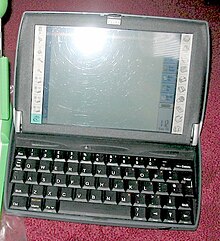 Psion netBook | |
| Developer | Psion PLC |
|---|---|
| Manufacturer | Psion PLC |
| Product family | Psion netBook |
| Type | Subnotebook |
| Generation | 4 |
| Release date | 1999 |
| Lifespan | 1999–? |
| Operating system | EPOC32 |
| CPU |
StrongARM SA-1100 190 MHz Intel XScale PXA255 400 MHz |
| Memory | 32, 64, 128 MB |
| Removable storage | CF II ( Microdrive), PC Card |
| Display | VGA or SVGA |
| Input | QWERTY keyboard, microphone |
| Connectivity | RS-232 serial port |
| Marketing target | businesses |
| Predecessor | Psion Series 5 |
| Language | Open Programming Language |
The Psion netBook is a small subnotebook computer developed by Psion. Released in 1999, it was for the mobile enterprise market. [1]
Description
Similar in design to the later, consumer-oriented Psion Series 7, the netBook has a clamshell design, a Video Graphics Array (VGA) resolution touch-sensitive colour screen, 32 MB random-access memory (RAM), 190 MHz StrongARM SA-1100 processor and a QWERTY computer keyboard. The RAM is upgradeable by adding an extra 32 MB chip. The netBook is powered by a removable rechargeable lithium-ion battery, giving a battery life of 8 to 10 hours.
The netBook runs the EPOC ER5 operating system, the predecessor of Symbian OS. Unlike the Psion Series 7, the netBook operating system runs from RAM. A Java virtual machine runtime system (environment), conforming to Java version 1.1.8, is available.[ citation needed]
In October 2003, Psion Teklogix announced the NetBook Pro, replacing the original netBook. This was similar to the earlier model, but upgraded with a 16-bit colour Super VGA (SVGA, 800 × 600 pixel) display, 128 MB of RAM, and a 400 MHz Intel XScale PXA255 processor running Windows CE .NET Framework 4.2 instead of EPOC. [2] It is also possible to run Linux on this model. [3]
An open-source project OpenPsion, formerly PsiLinux, ported Linux to the Psion netBook and other Psion PDAs. [4]
Included software
- Agenda – a personal information management program
- Bombs – a minesweeper game
- Calc – a calculator
- Comms – a terminal emulator
- Contacts – a contacts manager
- Data – a flat-file database program
- Email – an email, SMS and fax client
- Jotter – a multipage scratchpad
- NetStatRF – a Wi-Fi card monitor
- Program – an Open Programming Language (OPL) editor
- Record – a voice recording program, for use with the in-built microphone
- Sheet – a spreadsheet and graphing package
- Sketch – a drawing program (for use with the touch-screen interface)
- Spell – a spellchecker, thesaurus and anagram program
- Time – a world clock and alarm program
- Opera – a web browser
- Word – a word processor
The Netbook trademark
Psion registered the trademark NETBOOK in various territories, including European Union [5] and U.S. Trademark 75,215,401, which was applied for on 18 December 1996 and registered by United States Patent and Trademark Office (USPTO) on 21 November 2000. They used this trademark [6] for the netBook product, discontinued in November 2003, [7] and from October 2003, the NETBOOK PRO, later also discontinued. [8]
Intel began use of the term netbook in March 2008 as a generic term to describe "small laptops that are designed for wireless communication and access to the Internet", believing they were "not offering a branded line of computers here" and "see no naming conflict". [9]
In response to the growing use of this term, on 23 December 2008, Psion Teklogix sent cease and desist letters [10] to various parties including enthusiast website(s) demanding they no longer use the term "netbook". [11] [12]
During the twelve years since Psion first lodged the original netbook trademark, the term had become perceived as sufficiently generic that later derivative marks were rejected by the USPTO citing a "likelihood of confusion" under section 2(d), including "G NETBOOK" ( U.S. Trademark 77,527,311 rejected 31 October 2008), MSI's "WIND NETBOOK" ( U.S. Trademark 77,580,272) and Coby Electronics' "COBY NETBOOK" ( U.S. Trademark 77,590,174 rejected 13 January 2009).
References
- ^ "Psion netbook news release". PR News Wire (Press release). Archived from the original on 8 June 2011.
- ^ Vogel, Sandra (3 October 2003). "Psion NetBook Pro: a first look". ZDNet.co.uk. ZDNet. Retrieved 23 February 2009.
- ^ Linux on Psion Netbook Pro
- ^ "OpenPsion". SourceForge.
- ^ EUTM 000428250
- ^ "Psion Continues to Extend the Reach of E-business Strategies Beyond the Enterprise: Announces Support for Oracle8I Lite on Its New Netbook Device" (Press release). United Business Media. 26 October 1999. Archived from the original on 8 June 2011.
- ^ "Psion Discontinued Products". Archived from the original on 17 May 2007.
- ^ NETBOOK PRO Discontinued Archived 2011-01-04 at the Wayback Machine.
- ^ Paul Bergevin – VP and GM of Intel’s Global Communication Group.
- ^ Psion Cease and Desist Letter Archived 2009-03-26 at the Wayback Machine
- ^ jkOnTheRun.
- ^ Psion threatens netbook sites over trademarks.
External links
- Psion Teklogix website
- Psion Teklogix – EOL products